When thinking about buying a private cottage, they often wonder if it is gasified - using natural gas, you can save a lot on heating. But sometimes it is required to provide inexpensive heating and other buildings - a summer kitchen, a garage, a bath. Let's figure out whether it is possible to connect gas in a non-residential building, taking into account the legal norms and installation conditions.
At the same time, we will find out what the legal acts say about the use of gas in non-residential premises of apartment buildings, since the area of the first floors is often used for shops, hairdressers, offices.
The content of the article:
- General provisions of gasification
-
Non-residential premises MKD
- How is retraining done?
- Separately about basements and 2 floors
- How to connect suburban buildings to gas?
-
Bath gasification options
- Steam room inside a residential building
- Bathhouse in a separate house
- Conclusions and useful video on the topic
General provisions of gasification
Let's start with the basics, that is, with an understanding of where and for what purpose, in principle, gas equipment can be installed.
If we talk about residential buildings, then it is allowed to gasify any individual buildings, if a central or distribution main with natural gas is laid nearby. A branch is made in accordance with TU and a project specially created for specific conditions, and then by the gas service they lay a pipe to the house and provide fuel.

Gasification of a summer cottage or a cottage in which a family permanently lives has recently become easier thanks to new rules. Accessibility of the nearest gas pipeline remains the main problem
To develop a project for connecting a gas pipeline to non-residential facilities, it is necessary connection specifications, which can only be issued by a gas distribution organization.
The project should reflect the following points:
- the use of energy efficient equipment approved for use by federal authorities and having certificates;
- accounting and control of fuel consumption, installation of gas meters;
- the use of automatic control systems;
- required thermal insulation of equipment and gas pipeline according to design standards;
- control of the composition of combustion products and combustion temperature.
Simply put, all processes responsible for the production and accumulation of heat must be efficient in terms of heat transfer, safe for the environment and for maintenance personnel.
TU for the efficient use of fuel is issued by Rostekhnadzor, but first you need to collect a package of documents, which includes copies of the TU for connection to the gas distribution network and technological calculations, characteristics of all equipment, information on metering devices and control.
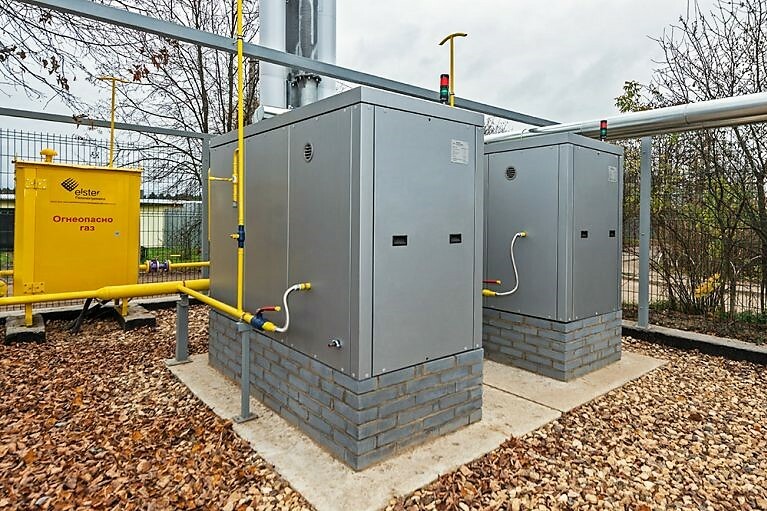
If gas equipment cannot be installed in the room, there are conditions when a boiler room equipped with special units is allowed to be located outside the building.
You can find out more detailed information about the legal framework by looking at the Safety Rules for Gas Distribution and Gas Consumption Networks or by contacting Rostekhnadzor.
There are often contradictions in the laws, and in reality you may run into problems, if you want, for example, to install a gas stove in a bath or equip a city office with a gas stove. And not just with problems, but with a ban on connection - therefore, consider the controversial cases encountered in practice.
Non-residential premises MKD
In apartment buildings of a residential urban or rural fund, gas is often used as a fuel for heating and hot water equipment. Five-story buildings with water heaters and gas stoves still account for a large percentage of the country's total housing stock, especially in the provinces.
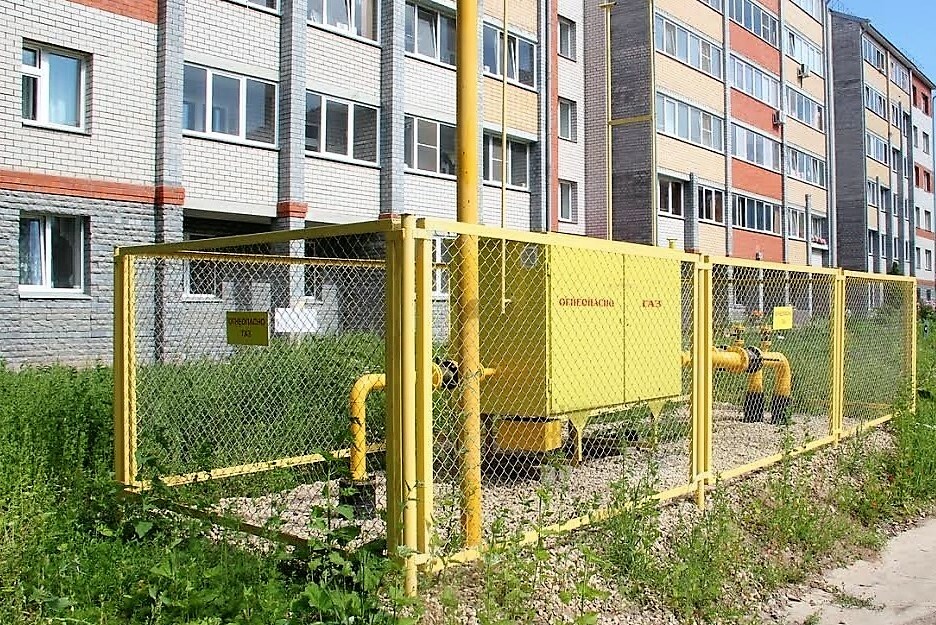
At the end of the last century, gasification captured almost all regions of Russia. Multi-storey buildings were connected to the central highways, according to the old edition of SNiP 2.08.01-89 - 9-storey buildings inclusive
In the new document SNiP 01/31/2003 (current edition SNiP 2.08.01-89) it is said that even now it is forbidden to install gas stoves on floors higher than the 11th, but there are no clear statements on the prohibitions. Hence, there are many disputes about whether it is possible to carry natural gas into non-residential premises, and, as a result, a series of court cases.
How is retraining done?
We are interested in non-residential premises - and these are areas that usually occupy 1-2 lower floors. When a residential building is commissioned, usually all apartments belong to the housing stock, therefore, they are equipped with gas equipment, respectively, they are gasified. But the first floors are bought up and used for offices and various service companies.
Let's say you want to convert your 1st floor apartment into a hairdresser and keep the gas stove. Is it possible? Most likely not, for two reasons.
First, you will have difficulties in the procedure for transferring residential premises to non-residential. According to the new rules, in order to organize an area in the MKD for a pharmacy, warehouse, office, store, workshop, etc., it is necessary to collect a huge package of permits and involve organizations such as BTI, FMS, ZhEK, UK.
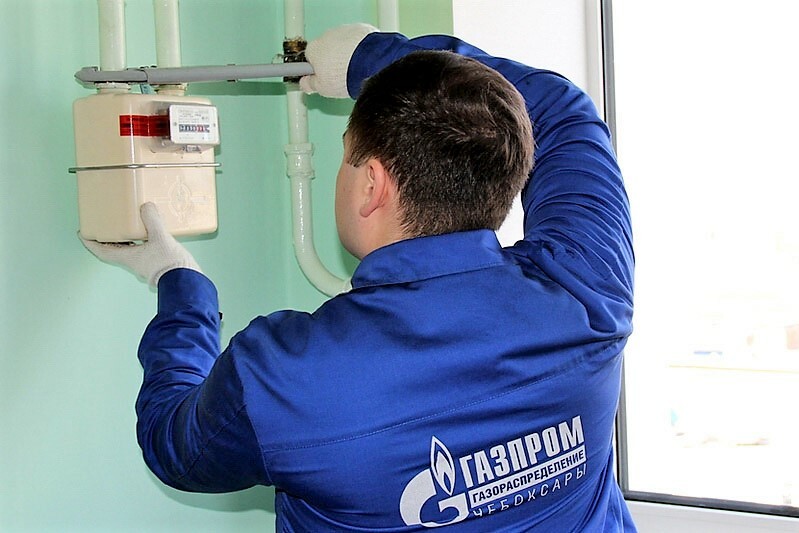
Payments by the owner of a non-residential premises are made in the same way as the owner of an apartment - according to metering devices: how much water, electricity, heat was spent - so much he paid
But the biggest hurdle aspiring entrepreneurs can face is impossibility of obtaining the consent of residents of the apartment building. Not everyone wants his entrance to turn into a "walk-through yard", and some suspicious subjects, waiting for their turn, occupied the benches on the playground.
Secondly, leaving gas equipment is likely to be banned. Moreover, at the expense of the owner of the non-residential premises, it will be necessary to cut off the gas supply pipe, and, if necessary, carry a new one to the floors located above. Simply put, you must ensure that gas is supplied to all residents of the house, bypassing your non-residential area.
Separately about basements and 2 floors
With 2 floors it is even more difficult: in non-residential premises, gas equipment still cannot be used, the highway will have to be cut off and moved. But there is one more point to start with - transferring an apartment on the 2nd floor to a non-residential premises is possible only on the condition that there is also a non-residential premises under it on the 1st floor.

In order not to complicate the process of transferring an area from residential to non-residential, many simply fulfill the requirements: they get rid of gas and install electrical equipment that is allowed in all types of apartment blocks
The requirements for basements are clearer. According to SNiP 21-01-97, where it is said about fire safety, flammable gases and other flammable substances must not be stored in basements and basements, therefore, gas lines must not be laid.
How to connect suburban buildings to gas?
It seems that it is easier - to gasify non-residential premises in your own summer cottage, for example, a bathhouse or a garage? However, many owners of garden plots and country houses are faced with the reluctance of gas distribution authorities to connect cheap fuel to buildings other than a residential building.

Installing a gas stove in a bathhouse easily solves problems with heating and heating water, in a summer kitchen - with cooking, and in a garage - with heating a large room in winter
There are many reasons for refusing to issue technical specifications and conduct gas:
- lack of a highway passing nearby;
- gas workers do not have the required amount of fuel to meet their needs;
- the room is not properly equipped;
- the equipment does not meet the requirements of fire safety and energy efficiency, etc.
But if you fully comply with all the requirements, and it will be possible to install a gas boiler or stove in a non-residential premises.
Simply put, if the design organization, and with it the service authority of the gas economy, is allowed, then gas can be supplied to any utility building.
Bath gasification options
Rarely does anyone refuse to build a bathhouse on their own site - this is not just a washing room, but a resting place associated with the mass of rituals and traditions of the Russian people. But it is too expensive to heat the bathhouse with firewood and even more so with electricity, therefore there is a logical desire to install a gas fireplace or a stove.
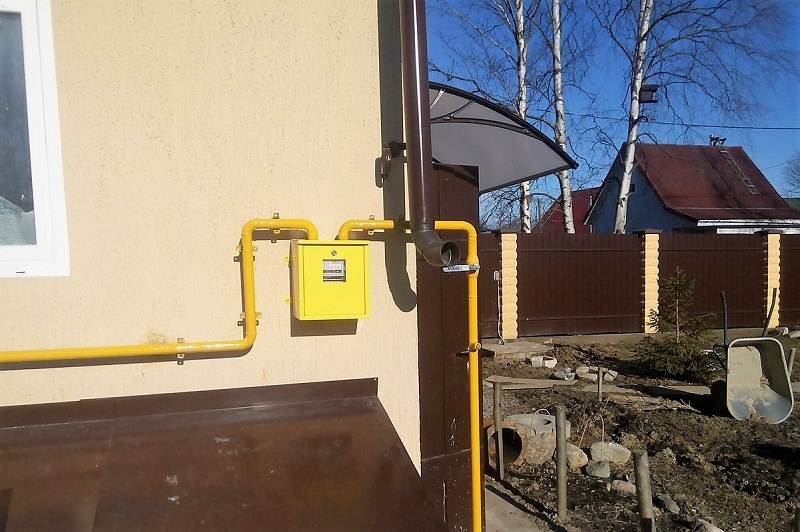
Maintenance of all equipment, home and bath, is carried out by the gas technical service using devices installed in one place - for example, on the wall of a house
But in reality, everything is complicated - the bathhouse does not meet legal requirements and is not considered a room suitable for installing gas equipment.
However, no one prohibits the supply of gas to residential buildings, so resourceful owners have found two legitimate options to bypass legal obstacles:
- add the construction of a bathhouse to the project for the construction of a house, that is, place them under one roof;
- register the bathhouse as a residential guest house with separate heating gas equipment.
Both options are actively used, and very successfully. But some owners of country houses were even more fortunate - they were simply given permission to gasify the bath. This also happens, therefore, in order not to waste extra efforts and money, first contact the gas workers - what if you are lucky?
Steam room inside a residential building
It turns out that no laws prevent the installation of a bathhouse right in the house, and many use this successfully. It turns out that the use of gas in non-residential premises of a residential building is possible.
True, there are several special conditions:
- you need to equip a separate emergency entrance;
- use only heat-resistant materials for the manufacture of doors;
- the emergency entrance can be opened from both sides;
- install a fire alarm and fire extinguishing system;
- only certified factory-made gas equipment may be used.
An interesting addition to the law - you cannot use the bathhouse for commercial purposes.
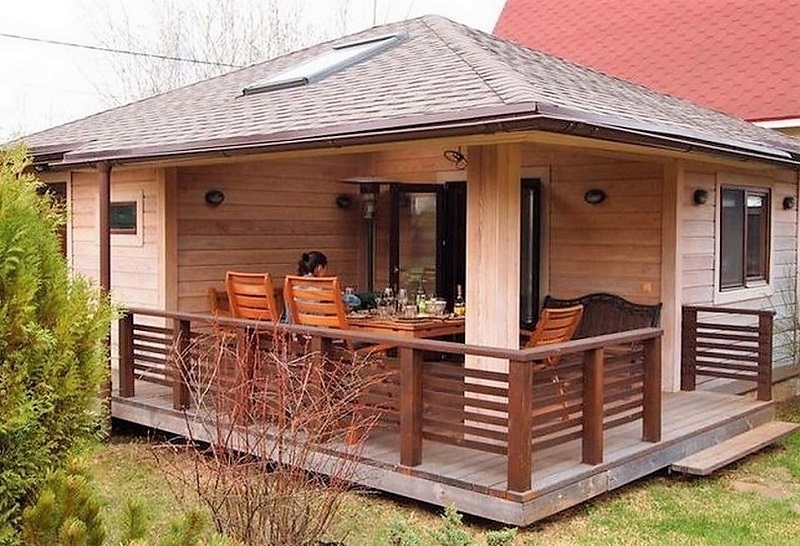
The entrance to the steam room can be arranged directly from the corridor or hallway, and the emergency exit to the terrace, which can easily replace the dressing room
If the inspectors of the gas or fire authorities are responsible for their duties, then they will not allow the operation of the bath without an automatic fire extinguishing system and a well-oiled ventilation.
But not everyone can allocate a piece of living space for a bath or sauna, so we will consider another option.
Bathhouse in a separate house
First, you will have to come up with a project for a guest house or a summer kitchen, which could later be converted into bath, that is, the building must have a capital foundation and walls with mineral insulation, lined with non-combustible materials.
The main point in the design will be gas boilerinstalled for heating and water heating. Usually, there are no questions about why a separate unit is needed.
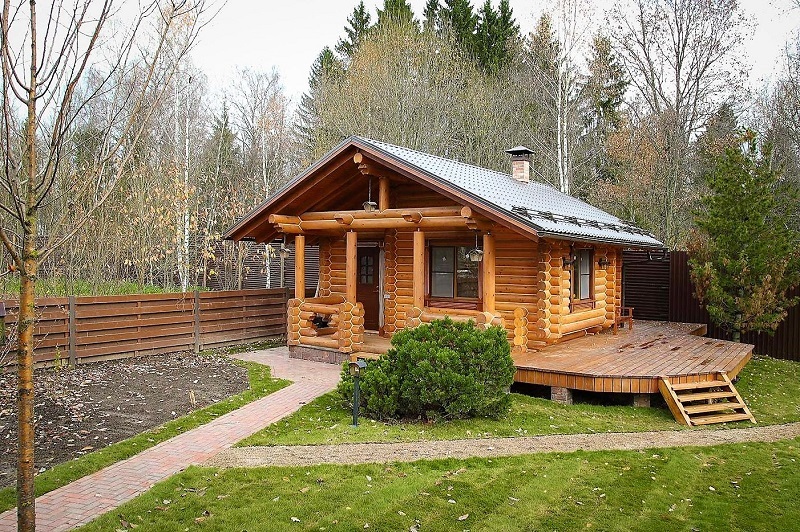
You will also need sewerage and shower equipment - but this is not surprising if it is designed for a guest house in which seasonal accommodation is planned.
The approved project is implemented and a house is erected, then it is registered with the BTI, changes are made to the general plan of housing construction and an application for gasification is written. If the inspector, after inspecting the premises, does not reveal any violations, then he will issue a permit and draw up a sketch of the location of the equipment and the gas outlet.
After the issuance of the technical conditions, you may have to adjust something, for example, do forced ventilation or additionally insulate the boiler installation site.
It remains to lay pipes and connect the boiler to the system. If a residential building is gasified, then making a branch will not be difficult and will not take much time.
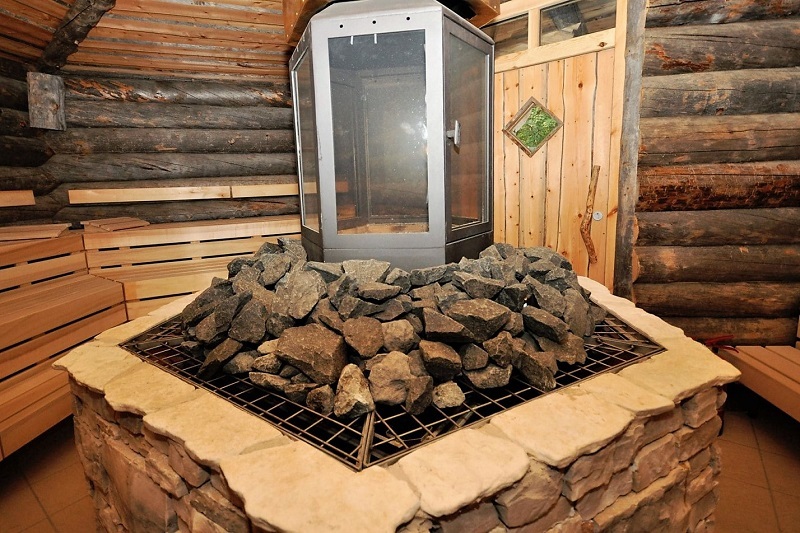
After testing and commissioning, the gas service representative gives the go-ahead for operation, and after he leaves, you can finally turn the house into a bathhouse - for example, arrange a heater
By the same principle, gas can be supplied to the garage. According to reviews, sometimes gas workers are allowed to conduct gas to any buildings, including garages - but subject to a number of fire safety requirements and ventilation device.
Conclusions and useful video on the topic
About the device of a bath with a gas oven:
It can be summarized that it is expensive, and more often than not impossible, to provide a bathhouse, a garage or to supply gas to a non-residential premises in an apartment building with blue fuel. However, before choosing heating or hot water equipment, we recommend that you contact the gas distribution service and inquire about the conditions under which you can gasify the room.
If the answer is no, then you will have to choose an electric boiler or stove. And we do not recommend to engage in amateur performances - fines only for the transfer of pipes start from 2 thousand rubles. rub.!
Have you ever faced the issue of gasification of non-residential premises? What difficulties did you encounter and how did you manage to solve them? Please share your opinion in the comments section.


